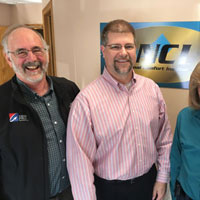
News
Carbon Monoxide: Remembering Rudy
By David Richardson
Our industry suffered a great loss on the evening of July 28th. Rudy Leatherman, a former carbon monoxide (CO) trainer with Bacharach, lost his life because of a tragic accident. Anyone who knew him could share stories of his enthusiasm, willingness to share, and positive attitude. Rudy was the teacher at my first CO and combustion training class sponsored by Bacharach in the late 1990s.

As I considered how much of an influence Rudy had on my career, I reviewed my notes from that class. I thought it would be fun to share the top three revelations I had from the class that changed my life. I hope you enjoy them as I use this article to remember Rudy.
Cracked Heat Exchangers
When I showed up to class, I thought I’d learn about how cracked heat exchangers were the leading cause of CO poisoning and ways to track those cracks down. On the contrary, Rudy explained why cracked heat exchangers rarely contributed to CO poisonings.
He taught us that there were other CO sources to be aware of, including appliances that most of us wouldn’t think twice about. Who would have thought to look at a gas oven or water heater before Rudy mentioned them? Our focus was on furnaces.
He also explained what happens between the airside and fireside of a furnace when there’s a cracked heat exchanger. I believed CO leaked through cracks, but that wasn’t the case. Instead, the blower pushes higher pressure air into the burner compartment and impinges on the flame. This creates a new set of problems to solve.
Rudy’s comments on cracked heat exchangers had a lot of guys during break disputing what he said, but I kept an open mind and continued to listen. After the break, he made another statement that hit home about how the only way to identify a CO source was to test. Rudy didn’t want the class to take his word for it. The subject was too important.
Proper Combustion Test Locations
I used to test for CO in the supply plenum or at a supply register with my Monoxor (CO single gas analyzer). If I didn’t measure any CO, then I assumed everything was safe. I assumed if there was a cracked heat exchanger, CO would leak into the airstream and I could measure it with a quality test instrument. Sounds good, right?
Rudy also dispelled this myth when he said, “You can’t find a CO problem testing in the duct. CO in a duct only shows the blower is circulating it. Anything that burns fuel, like a water heater, gas oven, or even an automobile might be the source. To diagnose the cause, you need to test each appliance.”
This is when I learned about where to test fuel-burning appliances to find the CO source. In natural draft equipment, the test location is before the draft hood. In 80% and 90% efficient equipment, testing in the flue pipe is correct.
Building Pressure Influences
I grasped building pressures before I met Rudy, but I never considered how they affected equipment operation. He opened my eyes to the potential for a combustion air grille to pull air out of a mechanical room.
I assumed that combustion air ducts brought outside air in while the flue pipe exhausted flue gas outside. But Rudy showed us how the reverse can happen if building pressures caused air (and flue gas) to pull from the wrong location.
It was at this moment that he mentioned the importance of draft, the force that controls combustion air. We learned how to test and diagnose backdrafting natural draft appliances. Then he brought up one potential solution – the double-acting barometric damper. He said, “If you want to learn how to use one of these, you need to find Jim Davis. He wrote the book on all of this and can teach you everything else you need to know.”
Don’t Delay
If it weren’t for Rudy, I wouldn’t be where I am at today. He started me on the path to test, diagnose, and fix CO and combustion problems. This eventually led me to write and teach on the subject. He created a desire in me to learn more. That’s what influential teachers do. He also encouraged me to go out and prove it to myself, not to take his word or anyone else’s for it.
If someone has made a big difference in your life, call them now and thank them. You may not have another chance. I understand this brief article doesn’t do justice to Rudy, but I hope it gives you a glimpse into the influence outstanding teachers have on their students. God bless you, my friend. We will miss you.
About the Author
David Richardson serves the HVAC industry as a curriculum developer and trainer at the National Comfort Institute, Inc. (NCI). NCI specializes in training focused on improving, measuring, and verifying HVAC and Building Performance.
If you’re an HVAC contractor or technician interested in learning more about adding carbon monoxide testing to your services, contact David at davidr@ncihvac.com or call him at 800-633-7058. NCI’s website www.nationalcomfortinstitute.com is full of free technical articles and downloads to help you improve your professionalism and strengthen your company.













